
Mathematical ImageryMathematical artists create strong, stunning works in all media and explore the visualization of mathematics
2015 Mathematical Art Exhibition
The 2015 Mathematical Art Exhibition was held at the Joint Mathematical Meetings held in San Antonio, TX. Here on Mathematical Imagery is a selection of the works in various media, including recipients of the 2015 Mathematical Art Exhibition Awards: "Penrose Pursuit 2," by Kerry Mitchell was awarded Best photograph, painting, or print; "Map Coloring Jewelry Set," by Susan Goldstine was awarded Best textile, sculpture, or other medium; and "15 Irregular Hexahedra," by Aaron Pfitzenmaier received Honorable Mention. The Award "for aesthetically pleasing works that combine mathematics and art" was established in 2008 through an endowment provided to the American Mathematical Society by an anonymous donor who wishes to acknowledge those whose works demonstrate the beauty and elegance of mathematics expressed in a visual art form.

Knitted hand-dyed wool, 2013. A $(p,q)$ torus link traverses the meridian cycle of a torus $p$ times and the longitudinal cycle $q$ times; when $p$ and $q$ are coprime, the result is a knot, and when not (ha!) the result is a $\gcd(p,q)$-component link with each component a $(p/(\gcd(p,q)), p/(\gcd(p,q)))$ torus knot. Here we have (in increasing order of complexity) a $(4,2)$ torus link, a $(6,4)$ torus link, and an $(8,6)$ torus link. Each is knitted so that both the knotting and the linking are intrinsic to the construction (rather than induced afterwards via grafting). They were made as proof-of-concept for the methodology for knitting torus knots and links that the artist introduced at the 2014 JMM. --- sarah-marie belcastro
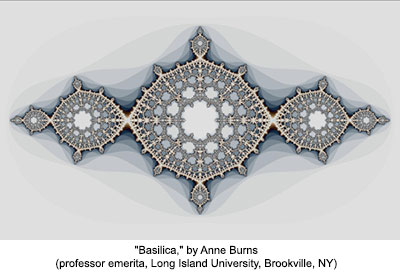
Digital print, 2014 The Julia Sets of $z^n + c$ are familiar objects to mathematicians. In particular $c = -1$ yields the well-known "Basilica". Adding a term $d/z(z^2-1)$ introduces three poles: $z=0, z=-1, z=1$. The orbits of initial points near the poles rapidly diverge to $\infty$ for very "small" (real, positive) $d$, amazingly, the boundary of the set of points whose orbit escapes (the Julia Set) contains an infinite number of tiny decorations resembling the decorations on the original "Basilica". --- Anne Burns
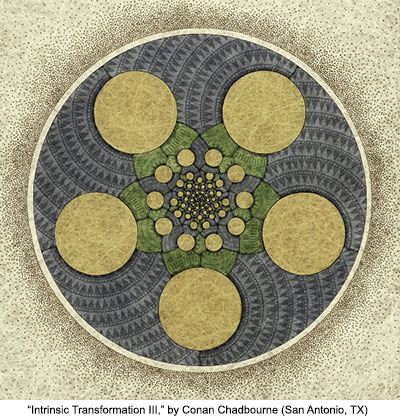
Archival inkjet print, 2014. This work is part of a series of visual meditations on the structure of the alternating group on 5 elements, also known as the icosahedral group. This image explores the structure of the icosahedral group through a particular presentation by two generators. The group's elements, which appear as yellow disks in this image, are arranged at the vertices of a rhombicosidodecahedron, shown here in stereographic projection, while the group's generators, of orders 3 and 5, correspond to the regions between the disks, colored green and blue, respectively. The image is composed of multiple hand-drawn images which are digitally composited and output as an archival digital print. --- Conan Chadbourne
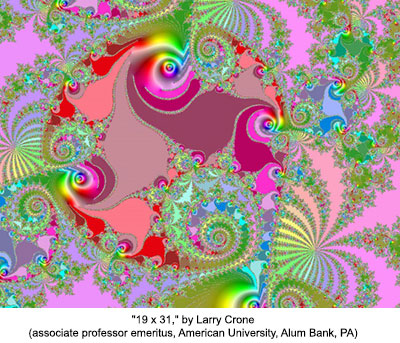
Print, 2014. In addition to its beauty, this image is of interest because the underlying quadratic rational function has an attracting fixed point cycle of order 19, and another of order 31. Just as a mountain presents many targets to a photographer, this function can be viewed from different perspectives, and it was hard to decide which one to use. The windows program Gplot, the camera which took this picture, is available for free download at http://www.american.edu/cas/faculty/lcrone.cfm. --- Larry Crone
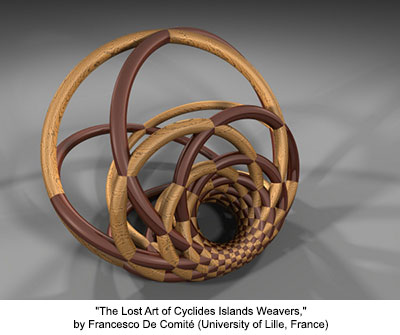
Digital print on cardboard, 2014. Dupin cyclides are the images of tori by sphere inversion. Since sphere inversion preserves circles, the set of Villarceau circles one can draw on a torus is transformed in a set of circles on the cyclide. The game is then to find nice images illustrating this fact, together with some story 'à la Raymond Roussel' to reinforce the magic. Manipulation of digital images, and use of ray-tracing software can help you to concretize mathematical concepts. Either for giving you an idea of how a real object will look or to represent imaginary landscapes only computers can handle. Things become yet more interesting, when you can transform your two-dimensional dream objects in real three dimensional sculptures. You can then handle your creations, and look at them from an infinity of view angles. --- Francesco De Comité
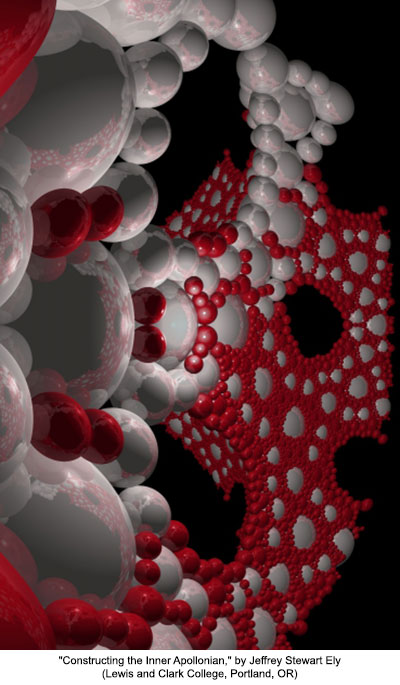
Digital print on archival paper, 2014. Unlike pictures of two-dimensional Apollonian gaskets, most renderings of the three-dimensional analogue, Apollonian sphere packing, tend to be disappointing because they do not reveal the interior structure the way that their two-dimensional cousins do. This image tries to reveal the inner structure in several ways. First, some of the larger spheres that obstruct the view have been removed. The negative spaces caused by their removal are plain to 'see'. Second, the observer has been located in one of these negative spaces, affording a more intimate view. Finally, the process has been deliberately left incomplete, giving a sense of both the coarser and finer stages of the construction. --- Jeffrey Stewart Ely
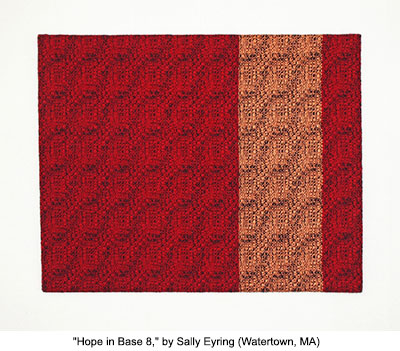
Woven cotton, 2013. Weaving technology is closely related to the computer industry - Hollerith cards were a direct inspiration from dobby looms. In this piece the word HOPE is translated into a weaving pattern using an 8 shaft loom. Using ANSII codes - A is represented as 101, B as 102, etc. up to Z represented as 132. First 100 was subtracted from each code to create a workable weave structure. Next, 1 was added to each code (using base 10) because weaving software programs number the shafts from 1 to 8. That resulted in representing A by 12, B by 13, etc. with Z represented as 43. Thus, the word "HOPE" is represented by 8 threads. Rotating the set of numbers by 1, 7 times, created a twill weave with a repeat of 64 threads, producing "HOPE", woven in base 8. The colors depict the colors of a sunrise; the red and orange raising out of the black of night. --- Sally Eyring

Ceramics, 2014. This sculpture is a fractal tree carried through five generations. With each iteration, the number of branches is tripled. The scaling factor from one generation to the next is the inverse of the square root of 3, approximately 0.577. As more and more branches are added, the top surface begins to display the classical fractal known as the Sierpinski triangle. --- Robert Fathauer
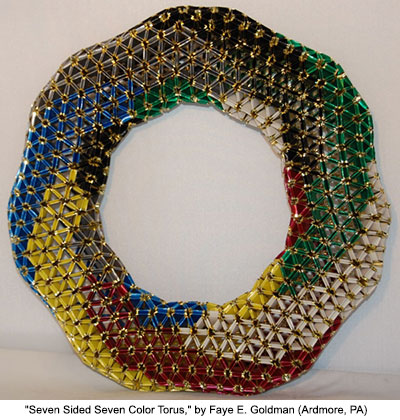
Strips of polypropylene ribbon, 2014. This toroid shape is made from over 3200 strips of ribbon. I love the fact that there needs to be as many heptagons making the negative curvature in the center as there are pentagons around the outside. It is the fourth torus I've made and the most interesting. When I decided to create a seven sided torus, it was obvious that it needed to have seven colors to show the seven color map problem on a torus. --- Faye E. Goldman
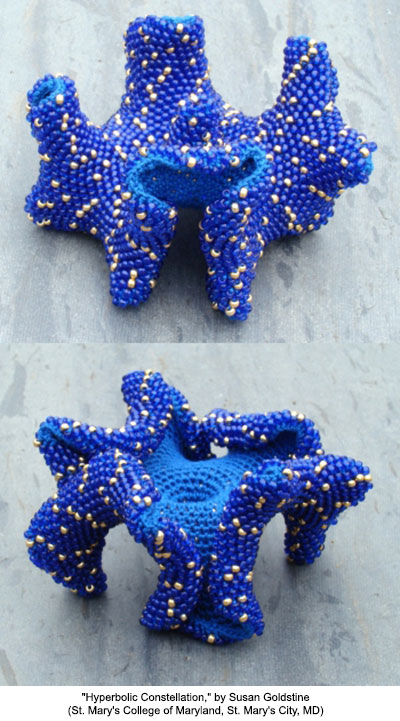
Glass beads, crochet cotton thread, 2014. Hyperbolic Constellation is inspired by Daina Taimina's innovative technique for crocheting hyperbolic surfaces. Her breakthrough is that if you crochet with an increase (made by stitching twice into the same stitch) every n stitches for a fixed number n, the result has constant negative curvature. I have always been curious about how these increases are arranged. While many artists have woven hyperbolic surfaces with beads, I have yet to see other examples of hyperbolic bead crochet, which moves more organically. In this pseudospherical beaded surface, the gold beads (every 6th bead on the thread) mark the locations of the crochet increases. The initial round contains 6 beads, while the outer edge contains 6 x 64 = 384 beads. --- Susan Goldstine
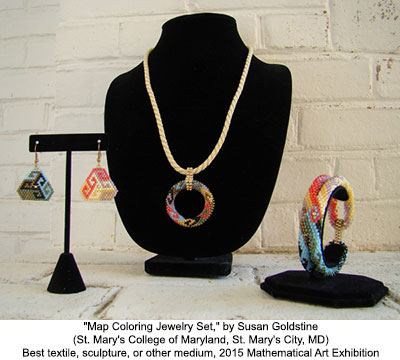
Best textile, sculpture, or other medium - 2015 Mathematical Art Exhibition
Glass beads, gold-filled beads, thread, ear wires, 2014. While every map on a plane can be colored with four colors so that no two adjacent countries are the same color, maps on other surfaces may require more colors. This jewelry set displays maps requiring the maximum number of colors for three surfaces. The bracelet, bead crochet with a bead-woven closure, is a double torus in eight colors, each of which touches all the others. The gold bead in the center of the pink and blue spiral is strictly ornamental. The pendant is a bead-crochet torus with seven colors, and all of the color contacts are visible from the front side. The bead-woven earrings are each four-color maps in the plane. With over 5300 beads in total, the entire set is wearable topology at its finest. --- Susan Goldstine
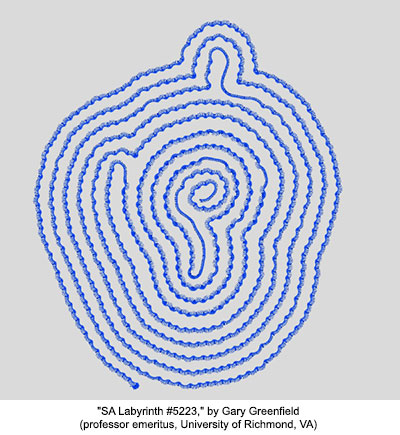
Digital Print, 2014. A point, realized as an autonomous drawbot, traces a curve parametrized by arc length by constantly adjusting its tangent angle and curvature. The drawing method was first introduced by Chappell. When it encounters itself, it strives to match its current curvature with its previous curvature. In non-degenerate cases this behavior yields labyrinths. Feathering the curve using a normal vector helps accentuate the drawbot's directional and curvature changes. --- Gary Greenfield
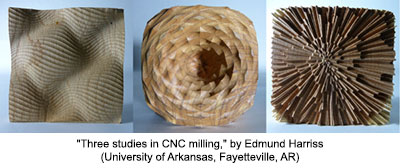
Oak and red cedar, 2014. Mathematician, Teacher, Artist, Maker. I like to play with the ways that the arts can reveal the often hidden beauty of mathematics and that mathematics can be used to produce interesting or beautiful art. These three designs show patterns that can be obtained running a CNC mill along lines. For the first two pieces the lines are defined purely mathematically. For the third the lines are constructed by an algorithm to lie at right angles to the grain. --- Edmund Harriss
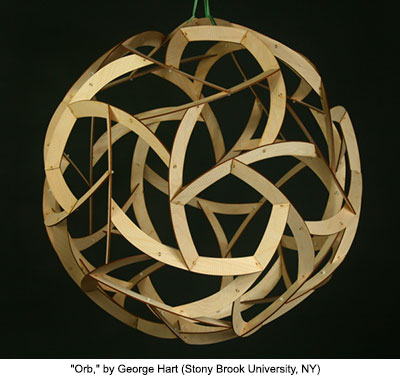
Laser-cut wood, 2014. As a sculptor of constructive geometric forms, my work deals with patterns and relationships derived from classical ideals of balance and symmetry. Mathematical yet organic, these abstract forms invite the viewer to partake of the geometric aesthetic. Sixty identical laser-cut and laser-etched wood components assemble easily with small cable ties, illustrating chiral icosahedral symmetry. Designed to be repeatedly reconstructed and disassembled in public workshops at MoSAIC math/art festivals, the separate parts travel conveniently in a small package. Orb has been assembled and disassembled multiple times by many groups of people. --- George Hart

PA 2200 Plastic, Selective-Laser-Sintered, Computer Animation (on a tablet computer), 2014. This sculpture was inspired by a question of Vi Hart. This seems to be the first physical object with the quaternion group as its symmetry group. The quaternion group $\{1,i,j,k,-1,-i,-j,-k\}$ is not a subgroup of the symmetries of 3D space, but is a subgroup of the symmetries of 4D space. The monkey was designed in a 3D cube, viewed as one of the 8 cells of a hypercube. The quaternion group moves the monkey to the other seven cells. We radially project the monkeys onto the 3-sphere, the unit sphere in 4D space, then stereographically project to 3D space. The distortion in the sizes of the monkeys comes only from this last step -- otherwise all eight monkeys are identical. The animation shows the result of rotating the monkeys in the 3-sphere. --- Henry Segerman and Will Segerman
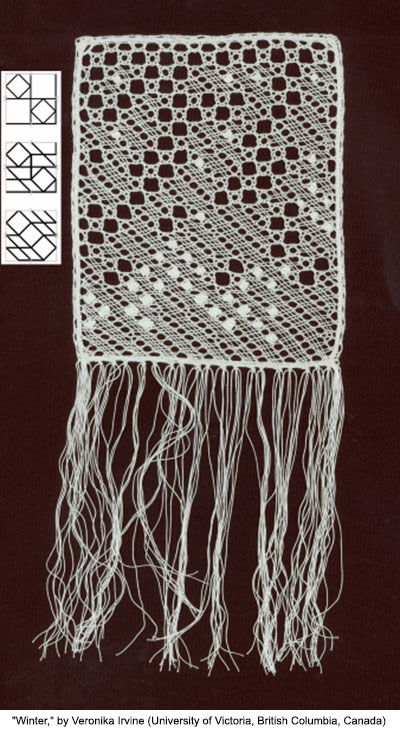
White cotton, DMC Cebelia No 20, 2014. Periodic bobbin lace patterns can be described by a mathematical model. Key elements of the model are 1) a toroidal embedding of a directed graph describing the movement of pairs of threads and 2) a function that maps each vertex of the digraph to a braid word. Using an intelligent combinatorial search, over 100,000 patterns matching the fundamental properties of this model were found. Of these, three closely related patterns were chosen (see inset). The three patterns can be transformed into one another by a small number of changes. The submitted piece was designed to show a gradual transition from one pattern to the next resembling the transformation from perfect, large snowflakes to the slanted, driving snow of a blizzard. When I first learned to make bobbin lace, some 20 years ago, I was struck by its mathematical nature. The patterns are diagrams, not a linear set of instructions. The order in which braids are worked and most of the decisions about how threads should move so that they arrive in the correct position as needed, are left up to the lacemaker. Over the past 4 years, I have been developing a mathematical model for bobbin lace and discovering the joy of designing my own pieces. See "Developing a Mathematical Model for Bobbin Lace.". --- Veronika Irvine
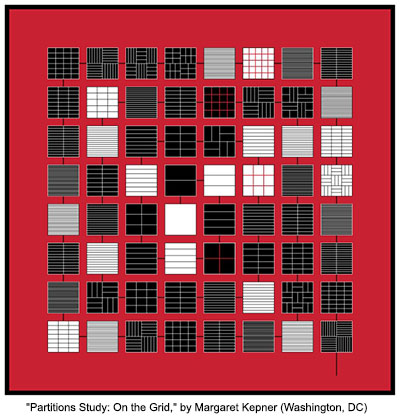
Archival Inkjet Print, 2014. A multiplicative partition of a number is an expression consisting of integer factors that produce the number when multiplied together. An unordered multiplicative partition is usually called a factorization. This work presents each of the factorizations of the integers from 1 to 28 in a symbolic representation based on subdividing a square. For example, 7' x 3" is a factorization of 21. It is represented by a square divided into a grid of 7 rows and 3 columns--see the symbol in the lower-left corner. The uniform grids corresponding to square numbers are highlighted in red. This piece is formatted so it can be cut in a spiral fashion and folded to create a 64-page accordion book of factorization diagrams. --- Margaret Kepner
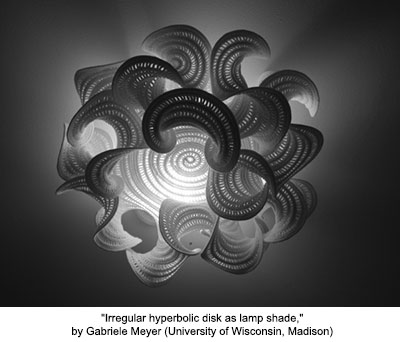
Photograph, 2013. I like to crochet hyperbolic surfaces. More recently I am interested in irregular hyperbolic shapes and how they interact with light. This is an image of a crocheted hyperbolic surface used as a lamp shade. The object itself is about 1 yard in diameter. On one side it has a more negative curvature than on the other, an irregularity, which makes it appear more interesting. The surface is created with white yarn, so that nothing detracts from the shape. --- Gabriele Meyer
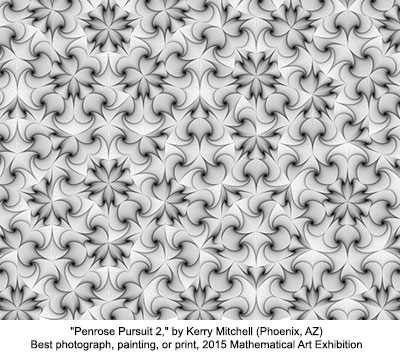
Best photograph, painting, or print - 2015 Mathematical Art Exhibition
Digital print onto aluminum panel, 2014. Underlying this image is a non-periodic Penrose tiling, using the kite and dart tiles. Each tile is rendered using pursuit curves. To accommodate the concave dart tile, it was split into two triangular halves. Each half was filled with three pursuit curves, while the kite tiles have four. --- Kerry Mitchell
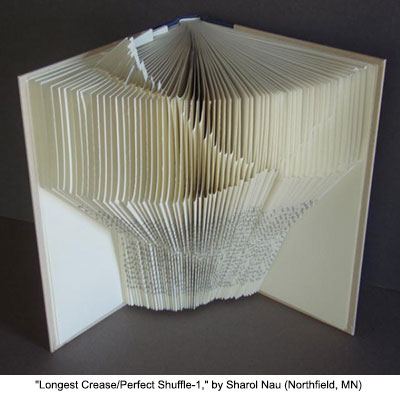
Folded Book, 2014. A classical calculus problem, the so-called Paper Creasing Problem is essential to the design of these sculptures. Pages in a book provide a series of rectangular sheets of paper which are creased by matching one corner; say the lower right-hand corner to a point on the opposite edge where the sheets have been bound. Waves are obtained through incremental changes in the length of the crease from page to page. Two sets of points have been used for these new examples. In each case every other page begins its sequence at a different point. The result of the two series interleaved is a so-called perfect shuffle. --- Sharol Nau
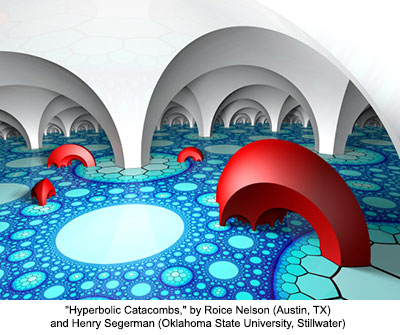
Digital Print, 2014. This picture visualizes the regular, self-dual {3,7,3} honeycomb in the upper half space model of hyperbolic 3-space. The cells are {3,7} tilings and the vertex figure is a {7,3} tiling. The cells have infinite volume: the vertices are "ultra-ideal", living beyond the boundary of hyperbolic space. The intersection of each cell with the boundary is an infinite collection of heptagons, together with a disk. The white ceiling and each red "creature" are isometric cells; for all other cells we only show the intersection with the boundary of hyperbolic space, on the floor of the catacombs. Every disk on the floor containing a {7,3} tiling is associated with an ultra-ideal vertex of the honeycomb. --- Roice Nelson and Henry Segerman

Honorable Mention - 2015 Mathematical Art Exhibition
Paper, 2014. This model was made from 180 units of four different types. It consists of 15 irregular hexahedra interlocked together. Each hexahedron has 2-fold dihedral symmetry and the positioning of each hexahedron is based on a pair of opposite edges on an icosahedron. This compound has the most complex weaving pattern out of anything I have designed, and is an example of a model where I extensively used the ray tracer POV-Ray as well as a computer program I wrote to aid in the design and folding/assembly process. --- Aaron Pfitzenmaier
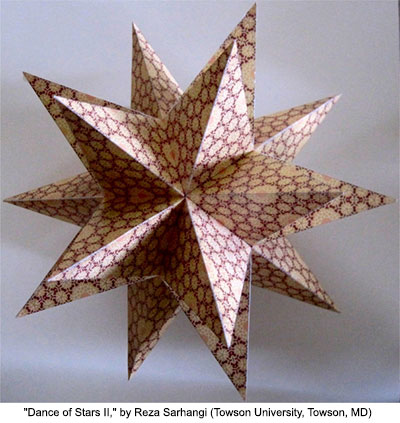
Heavy paper, 2014. Dance of Stars II is a decorated Great Stellated Dodecahedron, with Schläfli Symbol (5/2, 3), which has been patterned by the sâzeh module tiles, that are used in the majority of tiling that conforms to local fivefold symmetries. In an article that appeared in Science, the authors proposed the possibility of the use of a set of tiles, girih tiles, by the medieval craftsmen, for the composition of the underlying pattern. I used girih tiles and left the dashed outlines in the final tessellation. I also included rectilinear patterns that appear as additional small-brick pattern in the decagonal Gunbad-i Kabud tomb tower in Maragha, Iran. --- Reza Sarhangi (1952-2016)
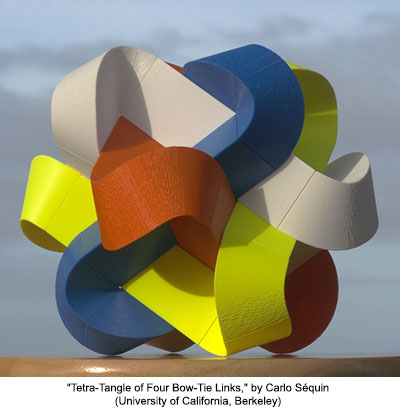
ABS plastic, printed on an FDM machine, 2014. Four sets of three mutually parallel, 3-sided prisms, pointing in 4 different tetrahedral directions, form the core of the TETRAXIS® puzzle. When two triangular prism-end-faces that share a common vertex are closed off with a connecting sweep, a loose "bow-tie" is formed. If all twelve pairs of adjoining triangular end-faces are joined in this manner, the result is a link of 4 mutually interlocking, twisted, prismatic bow-tie loops. This represents an alternating 12-crossing link that has the same connectivity as the "Tetra-Tangle," which I constructed from 4"-diameter card-board tubes in 1983. The new geometry is has been realized as 4 differently colored sets of 6 tubular snap-together parts each, fabricated on an FDM machine. --- Carlo Séquin


